| After that exciting day at Tagus Cove it was hard to believe there could be more. We were up at 5:30 a.m. and while we were having breakfast the captain left Isabela and sailed to Fernandina, the western most island, for a landing at Punta Espinosa. | 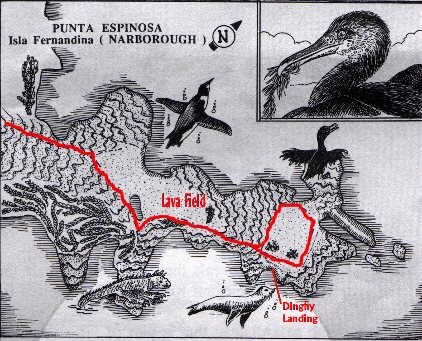 |
This is the youngest island in the Galapagos with the last volcanic eruption in 1995. The Volcano dominates the landscape and our hike took us across lava fields which flowed to the ocean. |
| Another one of my goals was to see the rare Marine Iguana which only lives on the Galapagos. Punta Espinosa has one of the largest colonies of Marine Iguana. Since food is so scarce on these islands these iguana adapted to live off the seaweed in the ocean often diving 40 feet deep. |
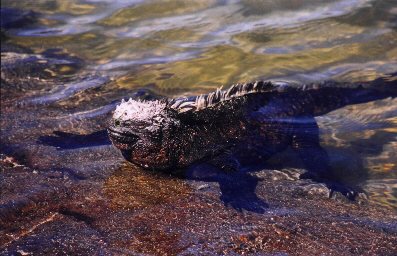 |
| Their bodies have developed unusual glands so their breathing system accumulates the excess salt in their bodies. Every so often we would hear a snort which was them blowing the salt out their nose. The salt then accumulates on their heads and body. |
| Darwin called the Galapagos "a paradise for reptiles" and found the dragon-like appearance of the marine iguanas, seen here warming themselves on the lava in the early morning sun, horrifying. He called them "imps of darkness... of a dirty black color, stupid and sluggish in their movement". Note their long fingers designed for hanging on to rocks underwater and on to the side of cliffs. Their black color helps these cold blooded reptiles to warm in the sun after feeding in the cold ocean. | 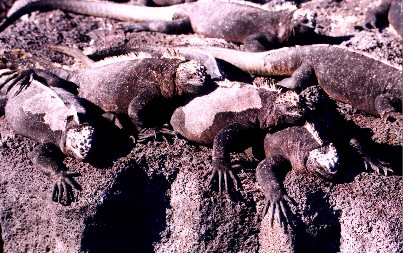 |
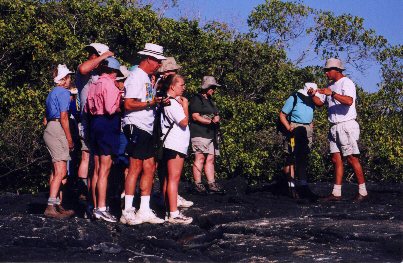 |
Here Roberto warns us to watch where we walk because it is difficult to see the dark iguana warming themselves on the dark lava rock. He explains that they climb on each other to preserve body heat during the night. Normally they are very territorial and will separate as they warm up. You can appreciate the advantage of traveling in a small group of only 16 people. Everyone gets personal attention. |
| Fernandina provided us with our first chance to see sea lions up close. As I mentioned earlier, sea lions have ears while seals do not. Also, the sea lions like to sit on the beach and sun while seals tend to hid in crevasses in caves alone the ocean. Sea lions also walk, or waddle would probably be a better term. The "bull" often is seen swimming off shore protecting his harem against young bachelors and marauding sharks looking for a meal. Since the sea lions have no enemies we can walk up close for a fitting photo. | 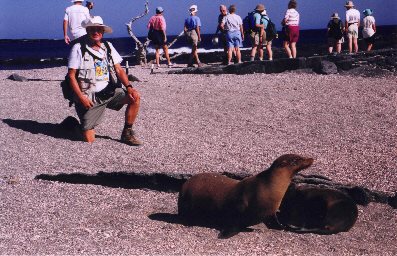 |
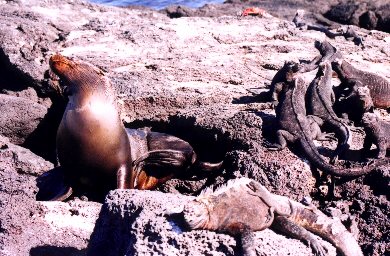 |
The sea lion and marine iguana live quietly on the lava flows going into the ocean. Sleeping and warming themselves in the sun is the only thing they have in common. When in the ocean the sea lion hunts for fish and the iguana seaweed so they don't compete for food. |
| The OAT brochure promised us an exciting swim with sea lions. What they promise, they deliver. After our hike over Fernandina we returned to the Millenium and changed into our swimming togs. Roberto filled the dinghy with brave swimmers and off we went to a volcanic cove protected from the high waves of the open Pacific. We jumped into the cool waters and the initial shock of the cold water was quickly overcome by the wonderful sights below. | 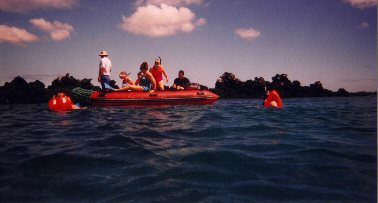 |
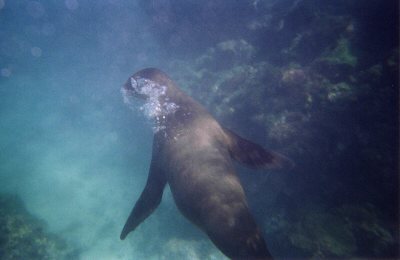 |
Taking their picture was difficult because the underwater cameras only allow you to point and shoot. An underwater camera with a flash is useful. You have to be fast on the trigger and hope you get a shot. This is the best I could do. The sea lion would be coming at me, I would get ready to push the shutter but before I could react the sea lion was gone. |
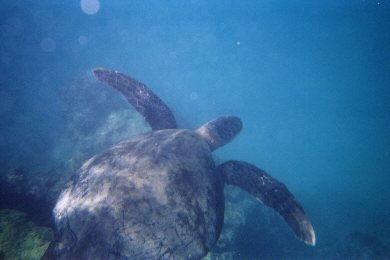 |
Because Fran and I scuba dive in Grand Cayman we are no strangers to the difficulty of underwater photography. Thus when we read that we would be swimming with the sea lions our inventory of things to pack included several "point and shoot and throw-away underwater cameras." As we swam in the cove with sea lions we also encountered a large sea turtle. Although they do not swim as fast as the sea lions they don't swim toward you either. They are fast swimmers so when you see one you have to swim fast and often deep - 12 feet or more. |
| I was surprised when I found this "chocolate chip" starfish. I had never expected anything like this. It was in about 12 feet of water and as I held my breath and dove from the surface I could see the layers of water temperature as I passed through them. The game plan was to point and shoot, quickly head for the surface for a breath of fresh air, and hope I got a picture. | 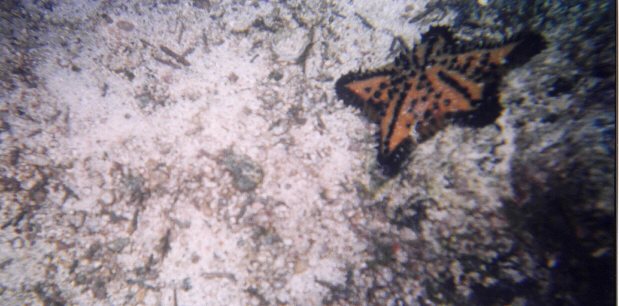 |
| After returning from our snorkeling trip, and as we changed cloths and had lunch, the Millenium traveled north east back to Isabela island and Vicente Rock. Here we are pointed out the erosion which takes place by eons of wind and surf. Although the lava originally flows sloped down to the sea they have been worn down and have left a rugged coast of cliffs and caves. Here you see our dinghy as Roberto takes us for a ride along the coast and into a large cave. On this trip we are treated to barking sea lions and the strange colors of the blue-footed boobies. | 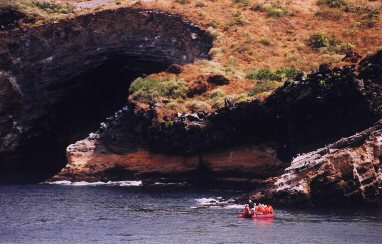 |
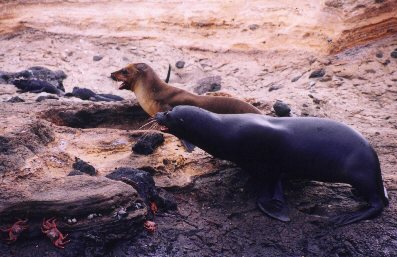 |
Watching the sea lions on the coast, and frolicking in the water next to our boat, was always a thrill. Here we see a bull and a calf. Roberto, who must be related to Dr. Doolittle, tells us the barking we hear from the darker colored bull is his telling his girl friend not to leave him. These naturalists know everything and you wouldn't want to leave Baltra without one. |
Oct 30, 2002.
| As we boarded the Millenium after our dinghy ride we headed north around the northern tip of Isabela. It was a beautiful afternoon and every headed for the observation platform on the third deck. Roberto joined us and told us that this is an area we should watch for whales. | 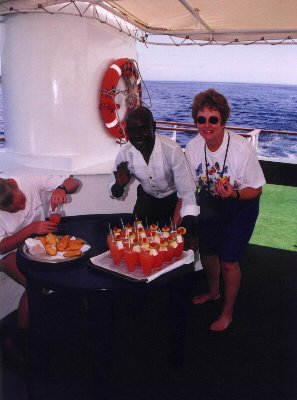 |
At 3:45 p.m. the boat whistle blew a long blast and Ernesto, our dinning room steward, brought a tray of empanadas, a local adult drink. At this moment we were passing over the equator and this of course is an event to celebrate. Two other times we had crossed the equator but they were both in the dead of night. This time everyone was awake and ready to celebrate. Its too bad the yellow line is below on the ocean floor so you can't see it. |
| As we sat on the observation deck we observed a volcano and the way in which the prevailing wind shapes the top of the cone. | 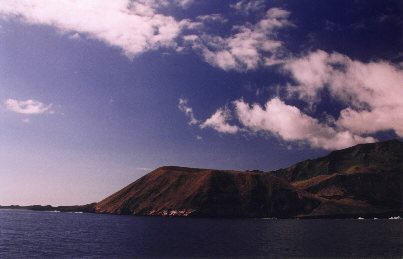 |
We think we saw a couple of whales but they were far off in the distance. At one time I thought I saw the fin of a shark but Roberto told me that it was probably the fin of an ocean sunfish which grows to gigantic size in this part of the ocean. Whatever it was, it was exciting. |
| As I have previously mentioned, the islands have been claimed, and settled, by many nations over the years. Thus each island can have many different names. Santiago seems to have the most names and this makes it difficult to look up in your guide book when you are trying to figure out what exciting mysteries and wonders we will see next. Fortunately, every night our resident naturalist, Roberto, would give us a lecture before dinner on where we were, where we were going, what we would see, what to look for, wet or dry landing, and what to wear. If you look at what we have on our feet in the photographs you can tell whether it was a dry or wet landing. | 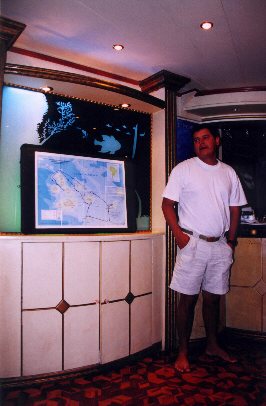 |
This evening we sailed north around Isabela, into the open wide rough Pacific and then headed south to San Salvador or as others might call it Santiago or James. While swimming with the sea lions I lost my sea sickness ear patch and felt too confident and didn't replace it. As the sun went down and the boat started to rock I knew I had made a mistake. While everyone else went to dinner I went to my cabin. All night long the boat rocked and rolled. But I knew that if I had it bad, the winners of the lottery who were sleeping in the deck above me were really having a ride. |
| Who said vacations are times to sleep in late and lay around all day? That is not the regimen when you are traveling in the Galapagos. Our wake-up call was at 5:00 a.m. Breakfast was at 6:00 a.m. and we "hit the beach" on Santiago at 6:45 a.m. This promised to be a long day. | 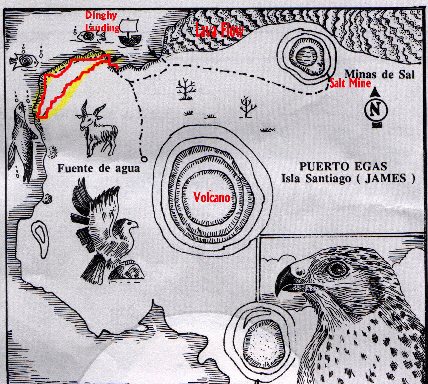 |
| Our landing site was on the northwestern side of Santiago. A wet landing on a black beach of volcanic lava. In the early morning sun the lighting was great for taking photographs. Once again you can see the effect of wind and waves on layers of lava ash as it was laid down over the years. | 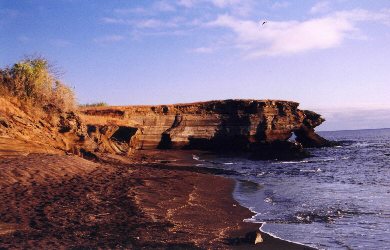 |
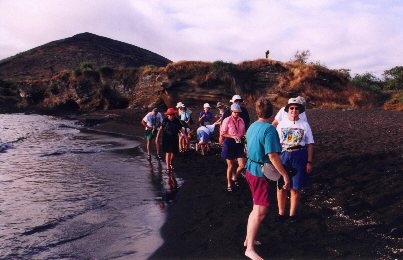 |
As you can see this was a wet landing because most people are wearing sandals rather than shoes. Every day as we board the dinghy Roberto tells us what to wear on our feet. Some days we are encouraged to take hiking sticks as well because of the uneven surface of the lava flows. Fran found the hiking stick most useful as a third leg to lean on. Here you can see a volcano in the background and the black lava sand. Behind us is a salt mine which we did not get a chance to visit. |
| I told you our day at Tagus Cove was fantastic. Some islands are better than others and I suspect that Santiago is on the bottom of my list - this doesn't mean it was bad, just that one of them has to be at the bottom. The beach (see photo above) was nice but there wasn't much to see on the island. Here we are hiking along the shore to see more iguanas, blue-footed boobies, and sea lions. |
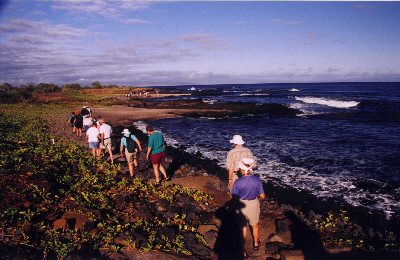 |
| As I had previously mentioned the naturalists job is to keep the groups separated. In the distance you can see another group of explorers being told about the island. Roberto did lead us to the Fur Seal grottos, one of the only places in the islands where Fur Seals can be seen. Unfortunately the seals like to hide in the dark overhangs of the rocky shore and thus my photographs didn't come out very well. Take my word for it, they were there and they looked a lot like sea lions without ears. |
| We took only a short hike on Santiago because we had much more exciting places to go. The island is dry most of the year and
thus the only vegetation are cactus, the red plants and short bushes that has a short growing season during the few months of rain in December
and January. You can see wind swept Sugarloaf volcano in the background. Attempts to settle on the island and mine salt proved unsuccessful not because of the lack of salt but because the living conditions were too harsh. "Water, water, everywhere, and how the boards did shrink. Water, water, everywhere, and not a drop to drink." (from the Rhyme of the Ancient Mariner) |
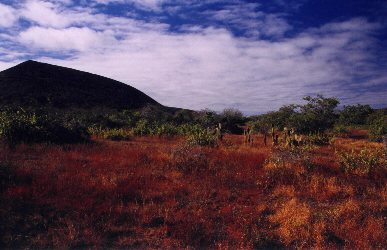 |
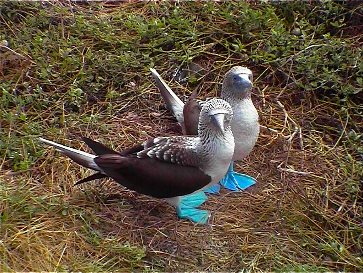 You have already heard a little bit about the strange blue-footed boobie - and there is more to come later. |
After leaving James Bay we sailed for Rabida, a small island with a beach famous for its dark red sand caused by the high iron oxide content. This was the greatest snorkeling spot on all the islands. | 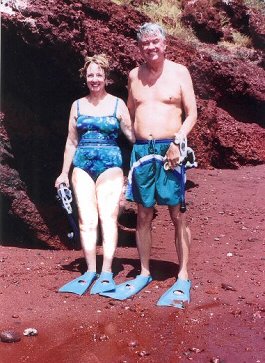 On Rabida we saw another specie of blue-footed boobies. They don't fly well, they can't dive very deep, but they mate for life and can always be found together. |
| We boarded the dinghy and left the Millennium carrying our snorkel gear and blue-footed boobie fins. We were dropped off on the beach and told to snorkel close to this lava outcropping. |
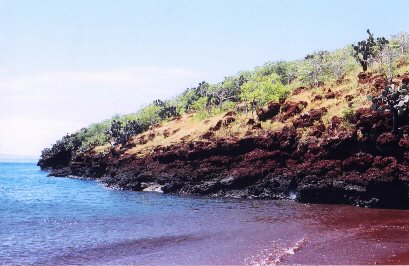 |
| You can see how the red sand turns the blue water red as it gets shallow close to shore. I was skeptical of what we might see and, to be honest [I always am - I'm a lawyer, remember], fully expected to see very little because we were going to snorkel so close to land where the water couldn't be very deep and there was little coral for the fish to feed on. |
| As we walked to the water we heard, "Arf, Arf, Arf". We listened more and I saw a cave into the lava right at the share and water line. "Arf, Arf, Arf" we heard again. With some trepidation I bent over and slowly went into the cave. Again I heard the echoing "Arf, Arf, Arf." This is what I saw. Notice his ears? Also, sea lions get up and walk on their front flipper legs whereas seals slide on their stomach. The dark color tells us it is a young male. Well, his nap having been disturbed by all these strange looking "boobies", he slowly waddled off into the water. | 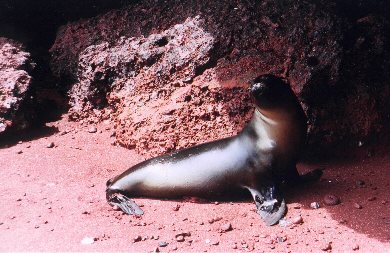 |
| I was overwhelmed with how deep the water got so close to shore. Next to the lava flow there was not the anticipated gradual incline but a sharp drop off into 20 or 30 feet of water. Naturally, I should have known, this was a lava flow! I hadn't gone very far when I realized the lava was honey combed with deep crevices and caves. | 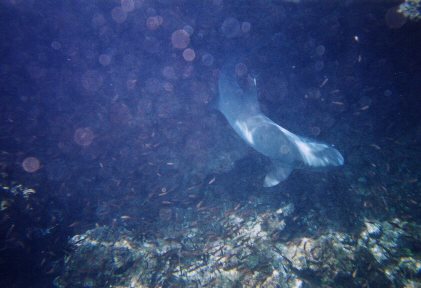 |
Naturally I had my underwater camera ready but I was not ready for this. A white-tipped shark came swimming out of a cave. At first my head bobbed above the water to yell "SHARK" so all my shipmates could see this denizen of the deep. I than took a breath of air and dove down. This is what I got. You can see the white tip on the top of his dorsal fin. |
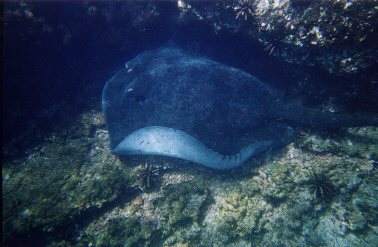 |
As I swam close to the lava flow I saw huge schools of sardines, a red and yellow puffer fish, and some sea-urchins. It is not uncommon to see sting rays in Grand Cayman but this is the largest one I have ever seen. It had to be 10 feet across slowly and gracefully sailing over the bottom of the ocean floor looking for food 20 feet below us. Like the shark, it was not disturbed by the snorkelers who gathered around to observe this creature. |
| In Cayman I have a rule, "See something new every time and no dive is complete unless I see a Queen Angel fish." In 10 years I have never been disappointed. The Queen Angel fish is a wonderful iridescent blue and yellow. I never expected to see the Queen Angel fish in the Galapagos. | 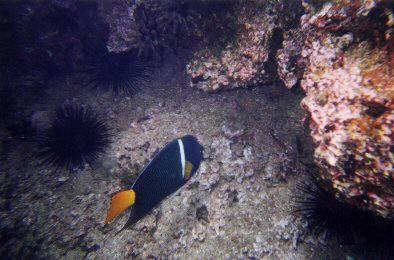 |
It had all the colors and could not be mistaken for a Queen Angel fish but it had white strip across its back. This was unique and just pointed out how things are the same and yet different. You can also see the black sea urchins with their porcupine type quills protecting them from being eaten. |
| It is impossible to show you everything I saw and some of my pictures didn't come out as well as I expected. I saw an octopus crawling across the rock ledge and I dove down for a picture. But the octopus can change colors to match its surroundings and it is difficult to make it out in the photo. So, you will have to be satisfied with this picture of another kind of star fish. It obviously isn't a "chocolate chip" star fish but it is every bit as unique | 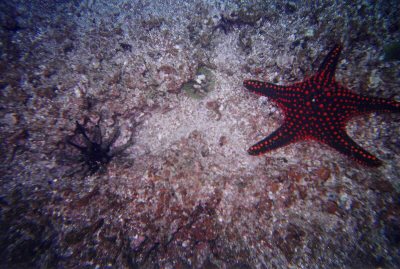 |
| Whenever our cruise ship headed for open water the crew would throw out a heavy line with a silver spinner and drag it far behind us. We learned that if we were sailing in open water and suddenly the engines cut off this meant we had caught a fish. We left Ribida and its wonderful snorkeling site about noon. As we were fed lunch the Millennium headed south for Santa Cruz. We finished our lunch and knew we were scheduled for a long afternoon and evening of sailing before we reached our destination of Ayoir Port. I laid down for a well deserved nap. I awakened from my snooze when I heard the engines stop. I grabbed my camera and headed to the back of the ship. The crew was pulling in the line which had hooked a 40 pound Wahoo. I was standing on the top deck filming the event when the crew tied a rope around the fish's tail and then threw me the line. Because I was high off the water's surface I had the leverage to pull the fish out of the water. So, I can honestly say, "on Father's Day, I caught a fish." | 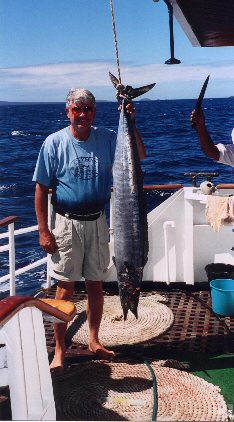 |
After the fish was safely tied from the second deck I was allowed to clean it using the knife you see being handed to me in the upper right hand corner. After I finished my chore the fish was cut up and stored in the ship's freezer. Later in the week we were served fresh fish. |
| Our resident poet described it this way: | When the engines ceased their whine,
|
If you have any questions about what you are seeing, or want some further information, feel free to
send me a note. 
If you are looking for a good tour book I recommend Ecuador & Galapagos published by Insight Guides. Although it covers a lot of Ecuador it has the greatest explaination and photographs of the Galapagos Islands. I bought my copy at Barnes and Nobel Bookseller after I returned.

Since October 19, 2002, you are visitor: